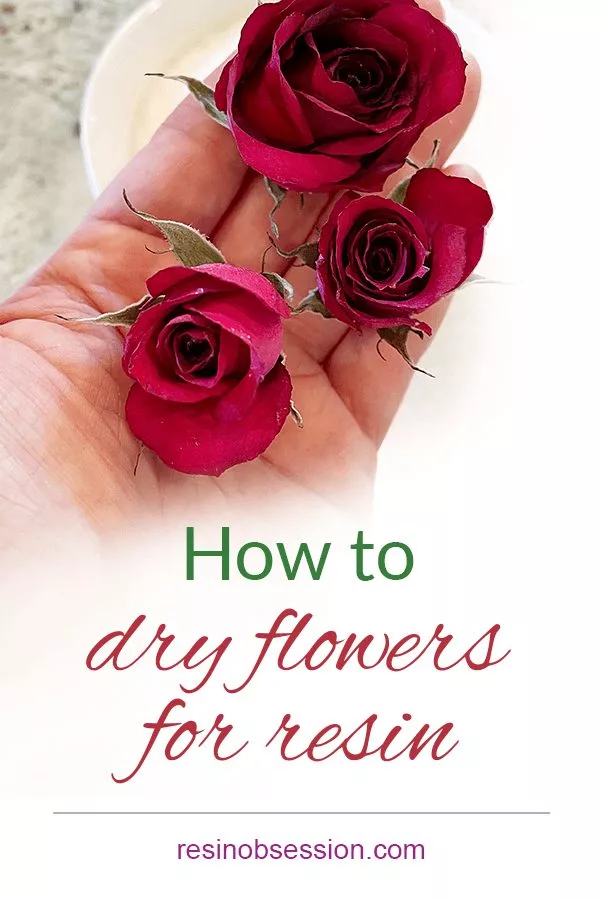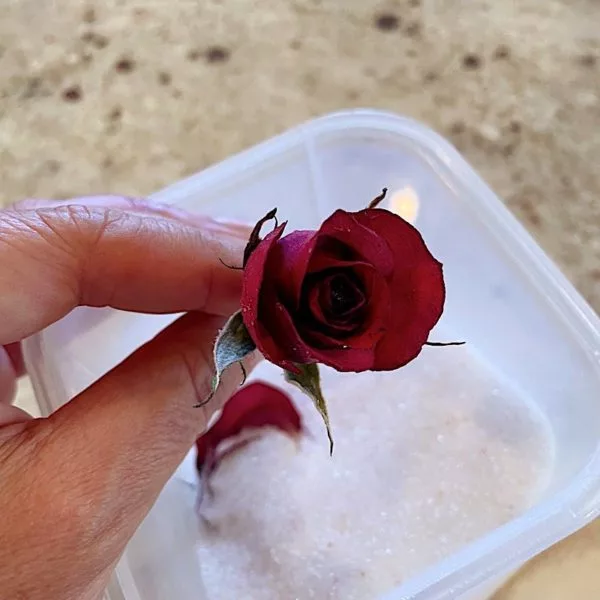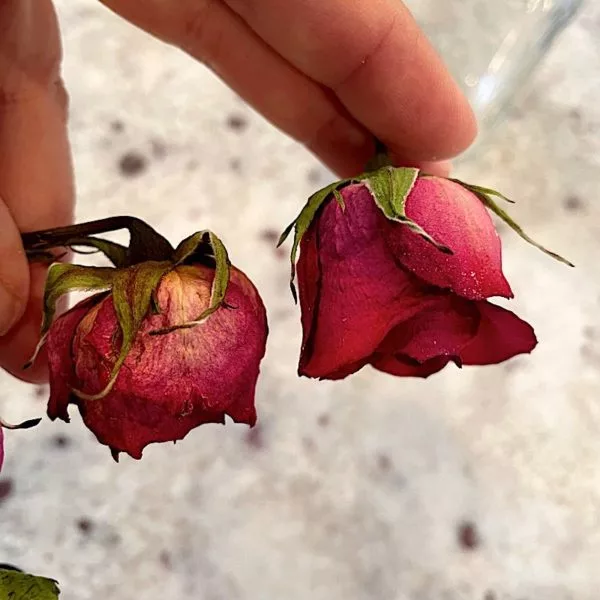
Why do flowers need to be dry before including them in resin?
If you don’t, the flowers will change color and look awful. Your radiant reds and gorgeous greens will turn the color of mud if you don’t dry them first. If you don’t believe me, you can see for yourself what happens when you put fresh flowers in resin.
Now that you know drying the flowers before putting them in resin is essential, how do you do that?
There are a few different ways, but one of my favorites is to use flower desiccant. It’s a sandy material that absorbs flower moisture. As a result, your flowers dry slowly but maintain their natural shape. I’m showing how to dry flowers that I’m using to make a resin vase.
Because I’m a little nerdy about my epoxy resin experiments, I let some of the roses dry naturally in a jar. I’ll share my results there, too, for comparison.
Step 1: Gather supplies
Besides fresh flowers, you will need a container with a tight-fitting lid for the desiccant.
Step 2: Add a drying layer
Pour a small amount of sand desiccant into the bottom of the container.
Step 3: Cut the flower
This part was the hardest for me. I very much wanted to enjoy these roses while they were full and colorful. But, to maintain the shape while drying, you must dry them before they go droopy. Be sure to leave a little bit of stem on them. This will help them stay upright in the container.
Step 4: Place in the container
Nestle the flowers in the sandy base leaving room between the rosebuds.
Step 5: Fill with desiccant
Fill the container so your flowers are completely surrounded by drying material.
Then, close it with a tight-fitting lid.
Step 6: Wait
It will take at least seven days for your flowers to dry. I left these roses in the container for twelve days. There was no real reason for that number except it was the holidays, and it wasn’t a priority to check on them.
Step 7: Remove the flowers
Open the container and pour off the sand.
Then, gently lift out the flower.
There will be sand particles that you will need to shake out.
Before I show you the results, here’s how I set up the other roses to air dry.
Step 1: Put in a jar
I grabbed a few other stems and put them in a glass jar without water. They stayed next to the ones in the container, but I got to enjoy these.
Step 2: Wait
Okay, so this is the more hands-off way of how to dry flowers for resin, and you might be tempted to do it this way. But before you do, look at these results.
The flower on the left is air-dried. It looks more crumpled and not as smooth as the desiccant-dried flower on the right.
When viewed from the side, you can see the desiccant-dried flower kept more of its original color.
💡 Pro tip: You know those packs you find in packages that say, ‘don’t eat this’? Those are silica gel beads. You can use them to dry flowers for resin. But, there is something you need to know first. Read this about using silica gel beads for drying flowers.
What do you do if you want to dry flowers for resin but don’t have days to do it?
If you don’t mind smashing the flowers flat, you can have dried flowers for resin in a couple of minutes. How? Use an appliance you probably have in your kitchen. Learn how to dry flowers in a microwave.
Now that you’ve learned how to dry flowers for resin, what’s next?
That’s where my ebook, Resin Jewelry Making, comes in. It gives you ideas on turning those dried flowers into jewelry you can keep, share, or even sell. Buy the ebook PDF now, and it’s yours to download in minutes.
Unpublished Blog Posts of Resin Obsession, LLC © 2023 Resin Obsession, LLC













This was very informative. Thank you. But how do you resin the flowers so as not to ruin them.
Hi Betty, what are you most worried about?
Where did you purchase the sand desiccant?
I don’t recall Judy, but if you search for ‘flower drying agent’, you should be able to find something.
I have my mothers dried flowers from her funeral that I’m wanting to add to resin, but the last one I did ended up with the resin around the flowers turning brown. What can I do to stop this? I really want a way to keep them forever as it’d be the last thing I had from her. They were hung upside down to dry.
Hi Lauren, are you sure your last flowers were completely dry? Here’s what happens when you put fresh flowers in resin: https://resinobsession.com/resin-frequently-asked-questions/can-you-put-fresh-flowers-in-resin/
Can I blow your mind? Put the desiccant (and the flower of course) in a microwaveable box with a snug lid, nuke it for 30 secs .. and you just saved yourself couple days of waiting. Im pretty sure even the most impatient personality finds this method very appealing.
🤯
I know! Melted my brain too 🙂
Hi! Thanks for the detailed steps. Can I include the whole stem and place it lying on its side when drying with silica? Thanks!
Sure, I don’t see why not.
Exactly what flower drying agent did you use?
Im trying to do a full bouquet with baby breaths and sunflowers and yellow roses amy tips
Hi Kandi, I show how to use them here: https://resinobsession.com/resin-tutorials/preserve-flowers-in-resin/
The link for using silica beads just brings you back to this page? Could you give more info please as I have some beads.
It’s the same process, Lisa.
I didn’t see that you mentioned not to breathe in the dessicant. It is extremely toxic and can cause lung cancer. Use gloves and your resin mask!!
Yes, always remember to use protection!
Can you pour more than 2 inches at a time? Is there any way to avoid the lines between pours? After the resin has cured, do you have to sand it or put a top coat on?
Hi Rhonda! I would never recommend pouring more than 2 inches of epoxy at a time. It gets super-hot and starts to bubble up ruining the project (been there). To avoid lines during the process I would recommend only allowing the first layer to cure slightly. This will allow for a seamless transition. After the resin is cured it should be good to go! You can always add a polish to it after to give it that extra sparkle! I like this one https://shop.resinobsession.com/products/promise-epoxy-polish-cleaner
Hi! Great tutorial, thank you! Your link “Read this about using silica gel beads for drying flowers.” is broken, it just links back to this same page.
Thank you! Removed that bad link!
Hi ! Its a great tutorial. Thank you for the step by step explanation. Can we use same desicant again? How many times can we repeat the same used dessicant ?
You’re very welcome—I’m glad you enjoyed the tutorial!
Yes, most desiccants can be reused, depending on the type you’re using. Desiccants like silica gel, which are commonly used in resin projects to control humidity, can be regenerated and reused multiple times.
How to Reuse Desiccants:
Silica Gel: Silica gel desiccants can be dried out and reused. To regenerate them, you can bake the silica gel packets in the oven at 250°F (120°C) for about 2-3 hours. This process drives the moisture out, making them effective again.
Indicating Silica Gel: Some silica gels are color-changing, so when they’re saturated with moisture, they change from one color (usually blue or orange) to another (pink or green). When you notice the color change, simply bake them as mentioned above to dry them out and reset the color.
Calcium Chloride or Clay Desiccants: Some other types of desiccants, like calcium chloride, may not be as easy to reuse because they absorb moisture in a more permanent way (they often dissolve into liquid when fully saturated). These should generally be replaced rather than regenerated.
How Many Times Can You Reuse?
With proper care, silica gel can be reused many times—potentially dozens of times—before it starts losing its effectiveness. Keep an eye on the performance; when it takes longer to absorb moisture or becomes less effective overall, it might be time to replace it.
So, in short, if you’re using silica gel or similar desiccants, you can regenerate and reuse them several times!